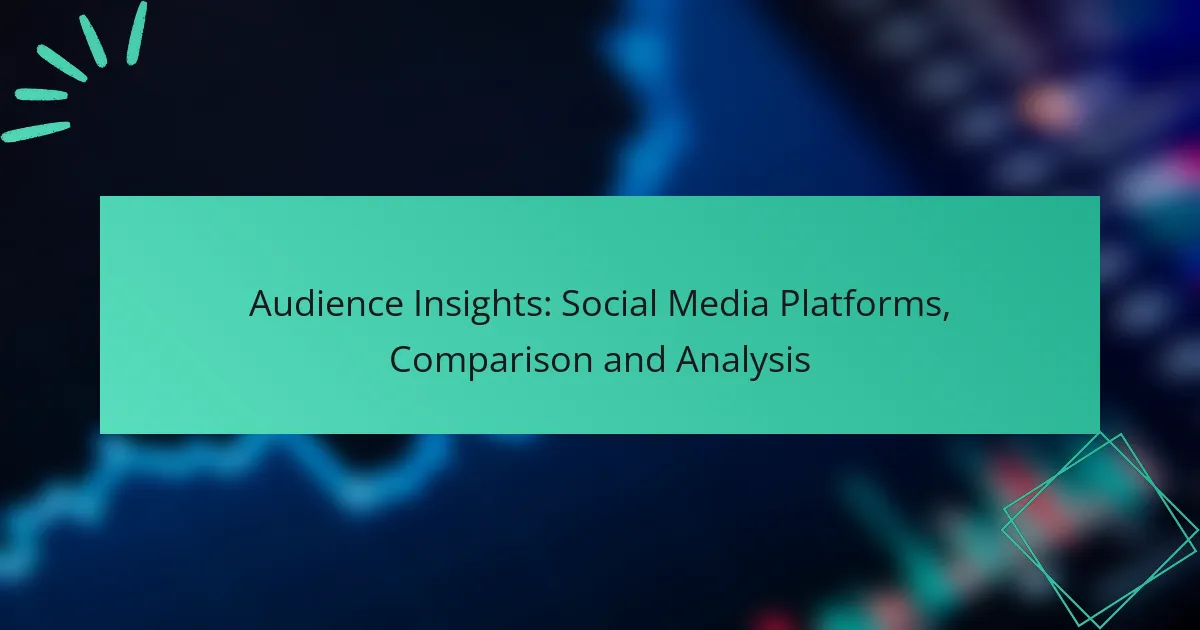In today’s digital landscape, understanding audience insights across various social media platforms is crucial for effective marketing strategies. Platforms like Facebook, Instagram, Twitter, and LinkedIn each offer distinct features that cater to different audience demographics and engagement levels. By analyzing these differences, brands can tailor their content and optimize their outreach to better connect with users.
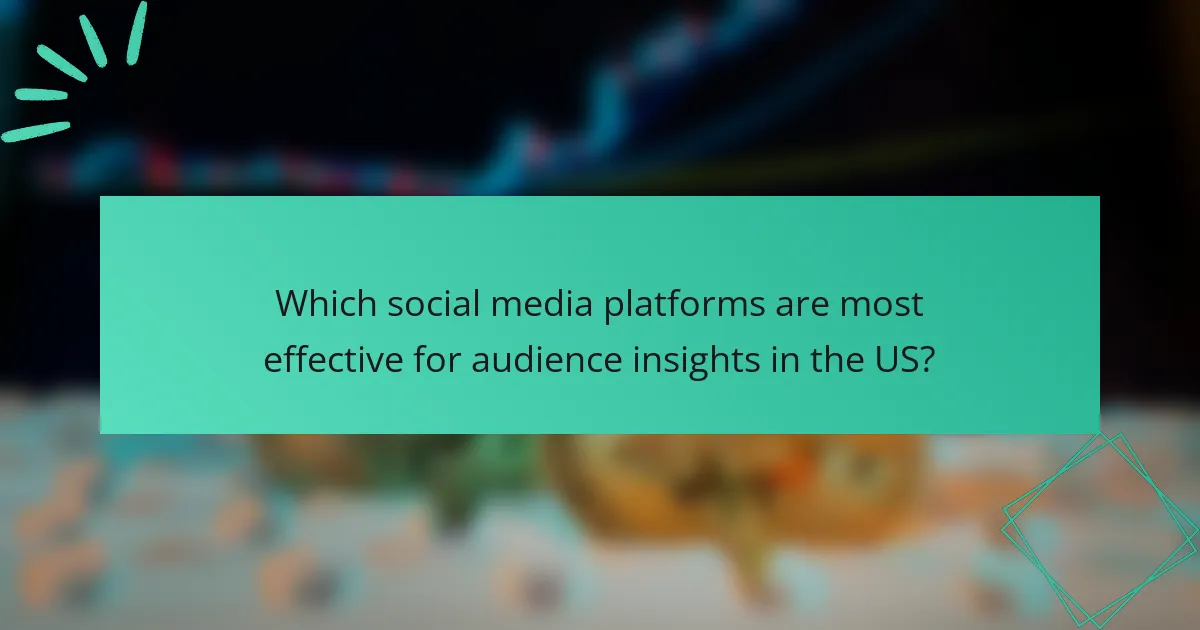
Which social media platforms are most effective for audience insights in the US?
In the US, platforms like Facebook, Instagram, Twitter, and LinkedIn provide valuable audience insights tailored to different needs. Each platform offers unique features that can help marketers understand their audience demographics, engagement levels, real-time feedback, and B2B insights.
Facebook for demographic targeting
Facebook is a powerful tool for demographic targeting due to its extensive user data. Marketers can access detailed insights about age, gender, location, and interests, allowing for precise audience segmentation. This capability is particularly useful for campaigns aimed at specific demographic groups.
Utilizing Facebook’s Audience Insights tool can help identify trends and preferences among different segments. For example, a brand targeting millennials might focus on content that resonates with their lifestyle and values, while a business aiming at seniors could emphasize reliability and ease of use.
Instagram for engagement metrics
Instagram excels in providing engagement metrics that reflect how users interact with content. Metrics such as likes, comments, shares, and saves offer insights into what resonates with the audience. High engagement rates often indicate strong connections with followers.
Brands can use Instagram Insights to track performance over time, helping to refine content strategies. For instance, if a particular post format garners significantly more engagement, it may be beneficial to create similar content in the future.
Twitter for real-time feedback
Twitter is ideal for obtaining real-time feedback from audiences. Its fast-paced nature allows brands to gauge public sentiment and reactions to events or campaigns almost instantly. Monitoring mentions and hashtags can provide immediate insights into how a message is received.
Using Twitter Analytics, businesses can analyze tweet performance and audience engagement. This data can inform adjustments to messaging or timing, ensuring that brands remain responsive to their audience’s needs and preferences.
LinkedIn for B2B insights
LinkedIn is the go-to platform for B2B insights, offering a wealth of information about professionals and companies. Marketers can leverage LinkedIn’s targeting options to reach decision-makers and industry leaders, making it effective for B2B campaigns.
Utilizing LinkedIn Analytics allows businesses to track engagement and follower demographics, helping to tailor content for a professional audience. For example, sharing industry reports or case studies can enhance credibility and attract the right connections.
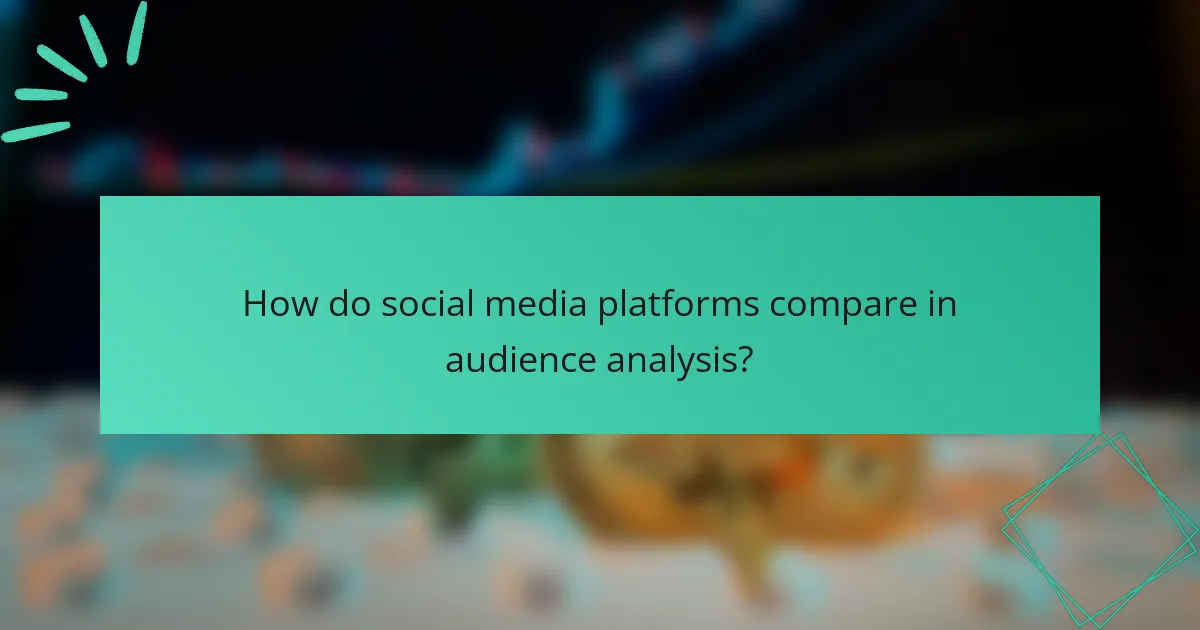
How do social media platforms compare in audience analysis?
Social media platforms vary significantly in audience analysis, impacting how brands engage with users. Understanding these differences helps in tailoring content and marketing strategies effectively.
Facebook vs. Instagram engagement rates
Facebook generally has higher overall user engagement due to its extensive features and larger user base. However, Instagram often boasts higher engagement rates per post, particularly with visual content, making it a preferred platform for brands targeting younger demographics.
When comparing engagement, consider that Facebook users may spend low tens of minutes daily, while Instagram users often engage for longer periods, driven by visually appealing content. Brands should focus on creating eye-catching visuals for Instagram while leveraging Facebook’s diverse content formats.
Twitter vs. LinkedIn audience demographics
Twitter attracts a diverse audience, including younger users and professionals, while LinkedIn primarily serves a professional demographic, making it ideal for B2B marketing. Twitter users often seek real-time news and trends, whereas LinkedIn users are more focused on career development and networking.
Understanding these demographics is crucial for content strategy. For instance, use concise, engaging tweets for Twitter, while LinkedIn posts should be more formal and informative, targeting industry professionals.
Content types across platforms
Different social media platforms favor distinct content types. Facebook supports a mix of text, images, videos, and links, allowing for versatile storytelling. Instagram is predominantly visual, favoring high-quality images and short videos.
Twitter is best for brief updates and conversations, while LinkedIn excels with professional articles and thought leadership content. Brands should adapt their content strategies to fit these preferences, ensuring relevance and engagement across platforms.
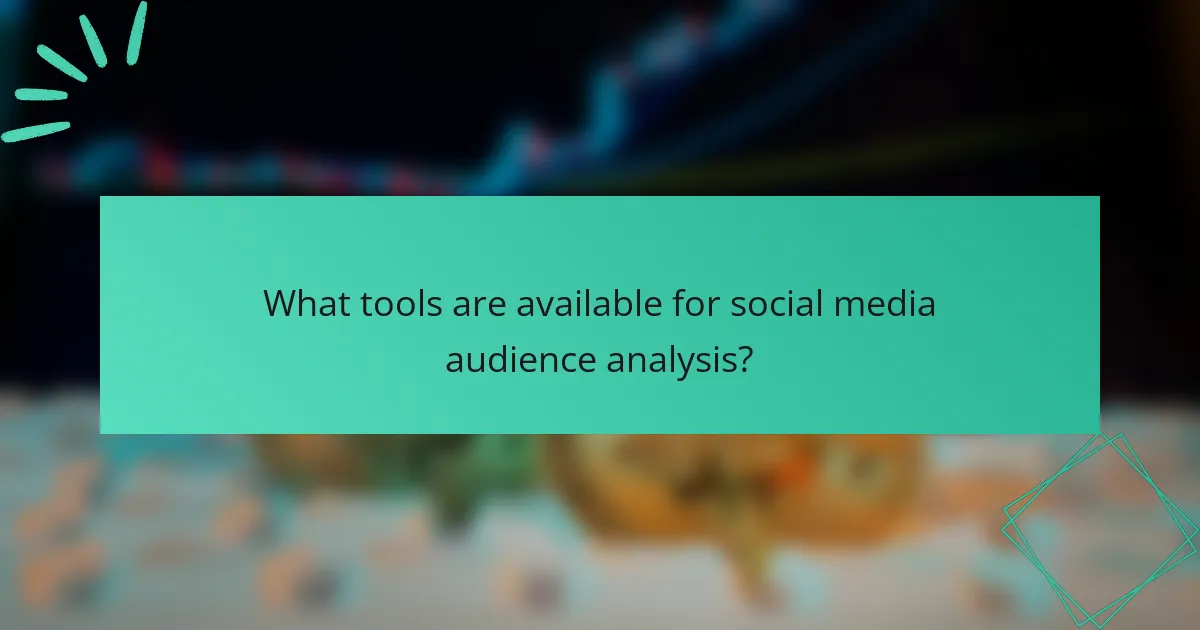
What tools are available for social media audience analysis?
Several tools are available for social media audience analysis, each offering unique features to help businesses understand their audience better. These tools can provide insights into user engagement, demographics, and traffic sources, enabling more effective marketing strategies.
Hootsuite for comprehensive analytics
Hootsuite is a powerful tool for comprehensive social media analytics, allowing users to track performance across multiple platforms. It provides detailed reports on engagement metrics, follower growth, and post performance, enabling businesses to identify trends and adjust their strategies accordingly.
To maximize Hootsuite’s capabilities, regularly review its analytics dashboard and set specific goals for your social media campaigns. This will help you measure success and make data-driven decisions.
Sprout Social for engagement tracking
Sprout Social excels in engagement tracking, offering features that allow businesses to monitor interactions with their audience. Its user-friendly interface provides insights into response times, message volume, and audience sentiment, which are crucial for improving customer relations.
Utilize Sprout Social’s reporting features to analyze engagement patterns over time. This can help you identify peak interaction periods and tailor your content strategy to better connect with your audience.
Google Analytics for traffic insights
Google Analytics is essential for understanding traffic sources and user behavior on your website, including social media referrals. By linking your social media accounts to Google Analytics, you can track how social media campaigns drive traffic and conversions.
To effectively use Google Analytics, set up goals and conversion tracking for your social media campaigns. This will provide clear insights into the ROI of your social media efforts and help you refine your approach based on performance data.
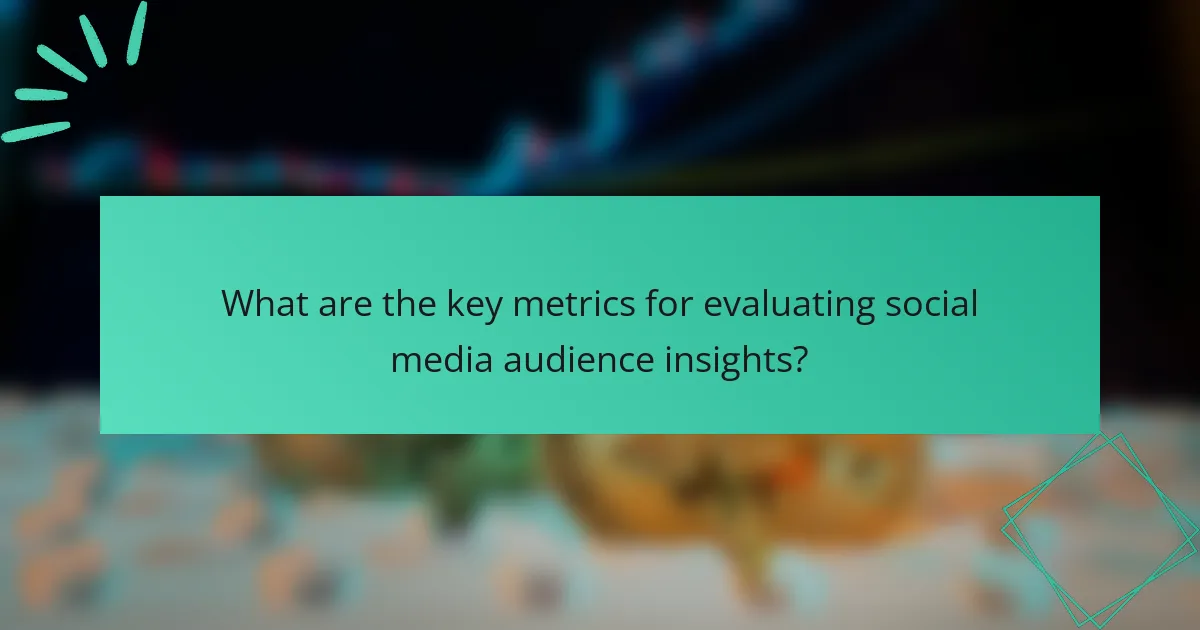
What are the key metrics for evaluating social media audience insights?
Key metrics for evaluating social media audience insights include engagement rate, reach and impressions, and follower growth rate. These metrics help assess how effectively content resonates with the audience and the overall performance of social media strategies.
Engagement rate
Engagement rate measures the level of interaction that content receives from the audience, typically expressed as a percentage of total followers or impressions. It includes likes, comments, shares, and other forms of interaction, providing insight into how compelling the content is.
A high engagement rate often indicates that the audience finds the content relevant and interesting. For many brands, an engagement rate of around 1% to 3% is considered average, while rates above 3% may signify strong audience connection.
Reach and impressions
Reach refers to the total number of unique users who see a post, while impressions count the total number of times a post is displayed, regardless of whether it was clicked. Understanding both metrics helps gauge the visibility of content across social media platforms.
For effective social media strategies, aim for a balance between reach and impressions. A high reach with low impressions may indicate that users are not engaging with the content, while high impressions with low reach could suggest repetitive exposure to the same audience.
Follower growth rate
The follower growth rate tracks how quickly a social media account is gaining followers over time, usually expressed as a percentage. This metric is crucial for assessing the effectiveness of marketing campaigns and overall brand appeal.
A healthy follower growth rate varies by platform but generally falls within the range of 2% to 5% monthly. To enhance growth, focus on creating shareable content, engaging with followers, and leveraging partnerships with influencers or other brands.
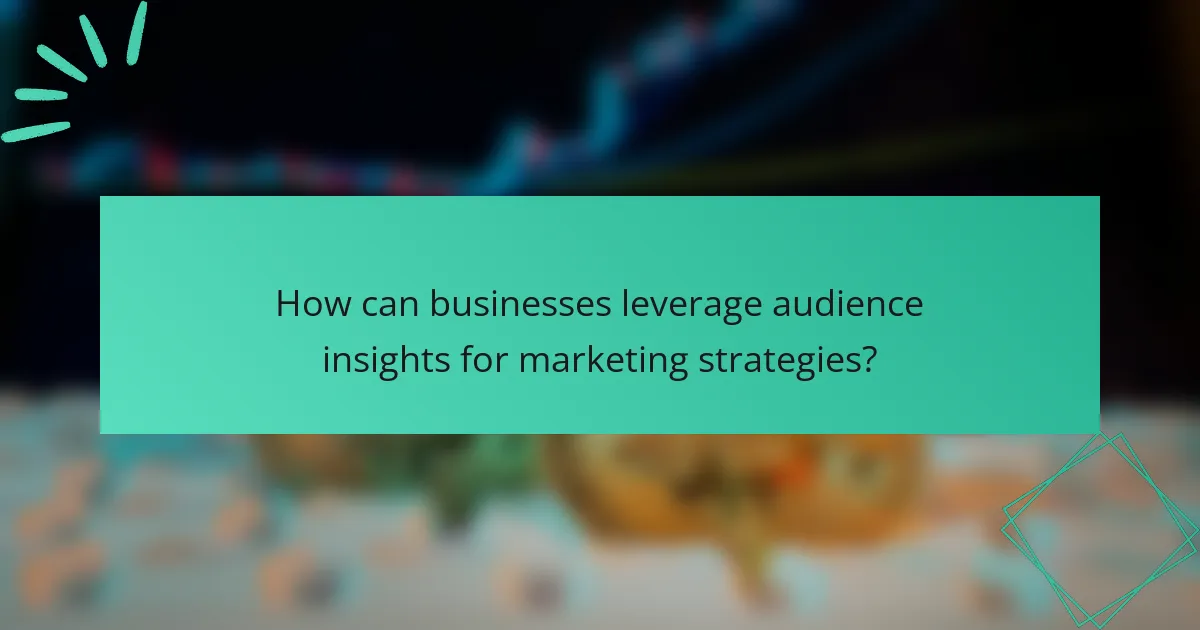
How can businesses leverage audience insights for marketing strategies?
Businesses can leverage audience insights by analyzing data from social media platforms to tailor their marketing strategies effectively. Understanding audience demographics, preferences, and behaviors allows for more targeted campaigns that resonate with potential customers.
Targeted advertising based on demographics
Targeted advertising enables businesses to reach specific audience segments based on demographics such as age, gender, location, and interests. By utilizing tools available on platforms like Facebook and Instagram, companies can create ads that speak directly to their ideal customers.
For example, a local coffee shop might target ads to users aged 18-35 within a 10-mile radius, promoting a special discount. This approach increases the likelihood of engagement and conversion, as the content is relevant to the audience’s characteristics.
Content personalization for user engagement
Content personalization involves tailoring marketing messages to meet the individual preferences of users, enhancing engagement. By analyzing audience insights, businesses can create customized content that resonates with specific segments, leading to higher interaction rates.
For instance, an online retailer can use browsing history to recommend products that align with a user’s previous purchases. This strategy not only improves user experience but can also increase sales as customers are more likely to buy items that feel personally curated for them.
Influencer partnerships for brand awareness
Partnering with influencers allows businesses to tap into established audiences and enhance brand awareness. Influencers often have loyal followings that trust their recommendations, making them effective for reaching new customers.
For example, a beauty brand might collaborate with a popular beauty influencer to showcase their products through tutorials or reviews. This partnership can significantly boost visibility and credibility, especially if the influencer’s audience aligns with the brand’s target market.
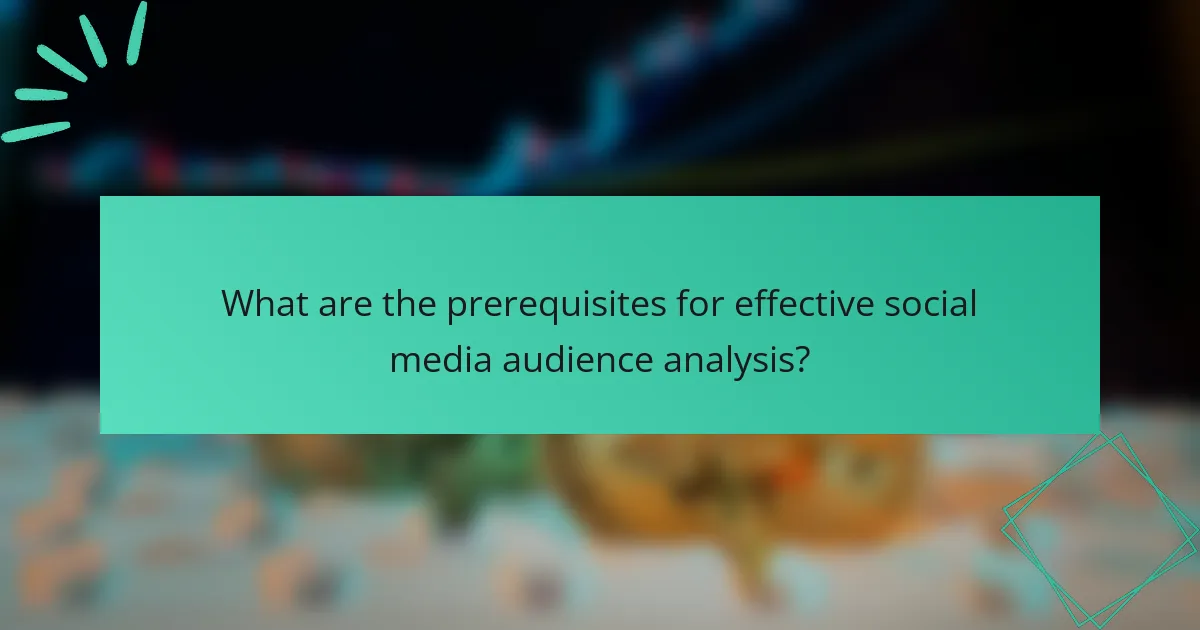
What are the prerequisites for effective social media audience analysis?
Effective social media audience analysis requires clear marketing objectives and a well-defined target audience. These prerequisites ensure that the analysis is focused and actionable, leading to better engagement and results.
Clear marketing objectives
Establishing clear marketing objectives is essential for guiding social media audience analysis. These objectives should be specific, measurable, achievable, relevant, and time-bound (SMART). For example, increasing brand awareness by 20% within six months can provide a clear target for your analysis.
When setting objectives, consider what you want to achieve with your social media presence. This might include driving website traffic, generating leads, or enhancing customer loyalty. Each goal will require different metrics and audience insights to measure success effectively.
Defined target audience
A well-defined target audience is crucial for effective social media audience analysis. Knowing who your audience is helps tailor your content and messaging to meet their needs and preferences. Start by creating audience personas based on demographics, interests, and online behavior.
Utilize tools like social media analytics to gather data on your existing followers. Look for trends in age, gender, location, and engagement patterns. This information can help refine your audience definition and ensure your marketing efforts resonate with the right people.
